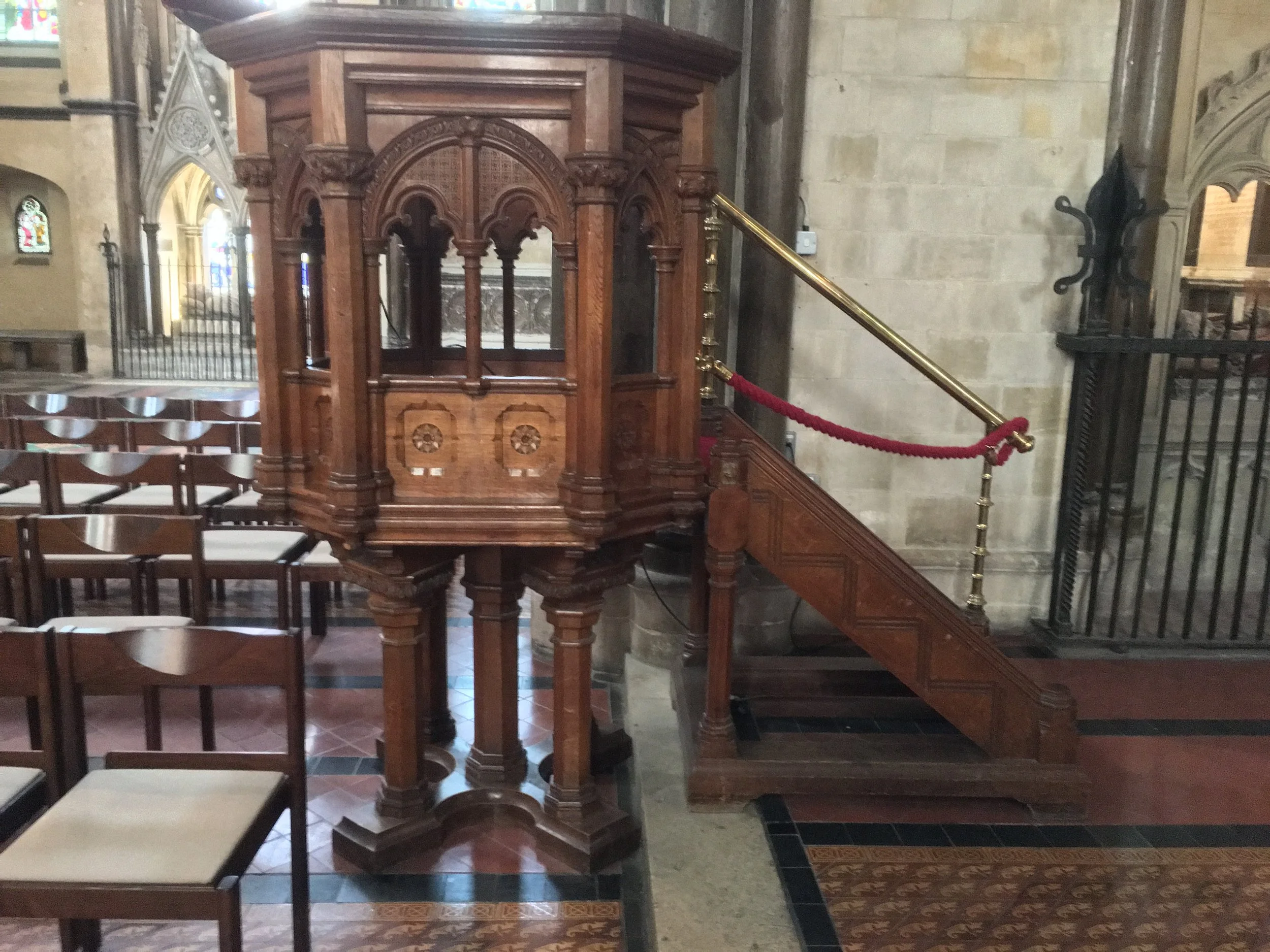Sir George Gilbert Scott furnishings, c. 1875
/Carolyn Foreman studies the liturgical furnishing designed by prominent architect Sir George Gilbert Scott during the major works at the Cathedral in the 1870s.
Cathedra (Bishop’s Throne), c. 1875
The carved oak cathedra located at the east end of the south half of the choir stalls was designed by Sir George Gilbert Scott c. 1875. It was donated by Lord Dudley, brother-in-law to Bishop Claughton. This cathedra replaced the previous throne designed by Lewis Nockal Cottingham in 1840, which was given to St Alban's and subsequently disappeared.
3D model of the cathedra in 2020.
It is in the Gothic style with a canopy of trefoil arched sides. The lower parts of the sides are carved with grapes and vine leaves, cluster column supports resting on seated lions and crocketted pointed arches topped by foliate finials.
The arms of some bishops were painted on the back by E.S. Watkin in 1910.
Pulpit, c.1875
Designed by Scott in 1875, the oak pulpit of octagonal form is decorated with cusped trefoil arches and columns with foliate capitals in a Gothic style, resting on five columns in a quincunx pattern. The pulpit replaced an earlier one by Cottingham which was moved to the Quire.
Photo of the pulpit in 2020
A flightf 5 steps with a brass hand rail on two turned supports leading to the pulpit which is 205cm in height and 111cm in width.
High Altar Reredos
The Caen stone reredos was designed by Sir Gilbert Scott in 1873. Given by Canon & Mrs Griffith. It depicts the Last Supper in high relief within a three gabled canopy. Marble columns support central gable.
3D model of the High Altar reredos in 2020.
Find out more about the donors Mary Elizabeth and John Griffith:
Mary Elizabeth and John Griffith, Canon of Rochester 1827-1879
T. H. James introduces Rev. Dr John Griffith and his wife Mary Elizabeth Griffith, benefactors to the Cathedral in the 19th century.
The reredos is screened during Lent along with the other icons:
Lenten veils, arrays and vestments
During Lent, the Cathedral joins many churches from the Anglican Communion and beyond in observing the tradition of veiling its crucifixes and icons. A giant Lenten array covers the High Altar Reredos and the vivid silk altar frontals and vestments used throughout the year are swapped for course undyed fabrics.
Find out more
Choir stalls
Some of the stalls carpentry survives from c. 1227 with traces of painting over a layer of plaster of white lead. The desk fronts decorated with linenfold panelling date from 1541 and were reconstructed G.G. Scott 1872. The quire desks consist of trefoiled arches on octagonal shafts supporting an oak beam. The whole reconstructed by Scott, including new carved Dean and Canons' stalls and seats against the north and south walls. Wrought iron stands in front of the front row.
Find out more about the 13th century choir stalls and the 19th-century alterations by Scott:
Choir stalls and associated furniture, 13th century
Charles Tracy studies the exceptional early thirteenth century choir stalls and associated timber furniture, with drawings and carpentry notes by Cecil Hewett. Featured in The Friends of Rochester Cathedral Annual Report for 1994-1995.
Explore
Carolyn Foreman
Rochester Cathedral Inventory, 1999
Reillustrated with additional notes by Jacob Scott, 2023
Sources
Palmer, G. H., 1897, The Cathedral Church of Rochester: a description of its fabric and a brief history of the episcopal see, London: George Bell & Sons, p 91.
Medway Archives, DRc/Ac 24.
This post was compiled from the 1999 Cathedral inventory:
The inventory
Carolyn Foreman investigates the historic inventories of the Dean & Chapter. Featured in The Friends of Rochester Cathedral Annual Report for 1998-1999.








